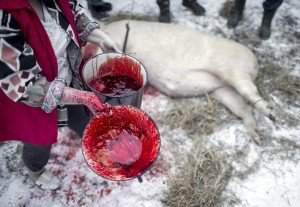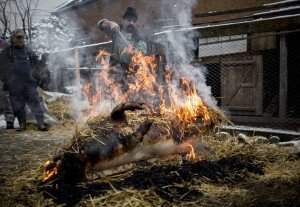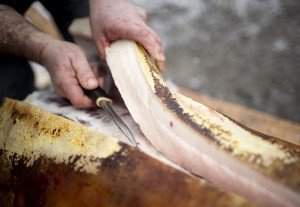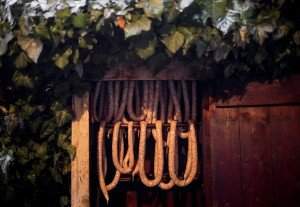Traditional Hungarian pigsticking

In former times people were obliged to find a way to profit from the cold weather since they didn’t have refrigerators. Winter was the time for preservation. A very important Hungarian tradition, pigsticking (‘disznóvágás’ that literally means ‘pig cutting’) was always held between András Day (30th of November, ‘Saint Andrew the pigsticker) and Ash Wednesday and was followed by a celebratory pig meal.
The pigsticking and pig meal is one of the most famous traditions at rural households during winter. They cut the fed up pig, process its meat and prepare a feast for dinner. This is one of those folkways that moved many people. They usually timed it around the coldest days of winter so that they could preserve the perishable meet.
Other folkways like chanting can be connected to pigsticking. Young people dressed in the traditional clothes typical of their region went around houses where they knew that they were having a pig meal and tried to convince the master of the house with poems and songs to give them a little taste of the feast. These chantings were usually successful.
Pigstickings are a bit different today than they were years ago, but they are still fun and many people go to the countryside to take part in one. Normally they don’t only eat the dinner but also other parts of the pig during the processing, like fried blood, roast, liver stew or cooked meat.
The never-ending row of pickles, preserved fruits and cakes is an indispensable part of the pig meal. And of course the real, fresh bread. These all together make quite a heavy dinner so it is advised to prevent stomach aches with the best medicine possible: drinking Hungarian schnapps or spritzer (pálinka).
The cutting of the pig
Pigsticking gives a big amount of meat to the families or the communities. According to szolnokinaplo.hu, the procedures can be divided into two big groups: the cleaning and the disassembly of the pig, and the different food making and preserving procedures.
In most places people have a drinking toast before they start working on the pig. The drinking toast usually means schnapps. Then, the work starts with the sticking of the pig. This is a communal job in which the pigsticker has the main role who sticks the pig with his knife while his helpers hold the pig. Children have to hold the pig’s tail.
They collect the pig’s blood and in many places roast it with onions for breakfast. In other places, it is the ingredient of the blood sausage. In a few households they benumb the pig with an electric shocker and the pigsticker cuts one of the pig’s cervical arteries for its exsanguination. They then collect and scald its blood.

The cleaning of the pig
In this procedure they remove the pig’s fur by first scalding or roasting, then soaking it in water and scraping it with a knife. This is followed by the bathing when they clean the animal. In some places they put the pig into a bath full of hot water, in other places they use a hose to pour water and scrub the pig’s skin.

The disassembly of the pig
They first make a cut on the pig’s abdominal side to remove its haslet and then cut off its head and leaf-lard. The disassembly has two types: they either cut the ribs near the spine or they cut the spine in the middle.
They clean the pig’s head, then boil and debone it. It is usually put into sausages. They freeze the pig’s grease so that it can be used later when cooking or baking. They scalp the spare ribs and preserve them. They remove the pork hands from the scapula with which they either make ham or sausage. They marinate and smoke the pork legs. They either consume the pork hand freshly or preserve it as an ingredient. The pig’s feet are usually cooked as a stew.

The processing of the pig
In this phase the preserving procedures happen side by side. They remove the skin of any meet that is left and boil the skin which will be put into sausages or pork cheese. They cook the lard, boil smaller meat parts and grind other meat parts along with leaf-lard for the sausages. They also make cracklings.

They boil the haslet and usually fill them into sausages. The most beautiful meat parts are marinated or put into the fridge. The most known pig parts are the ham, bacon and pork hand which are marinated and preserved by smoking. The ham is usually kept until Easter.
Photos: MTI
Copy editor: bm
Source: Daily News Hungary





